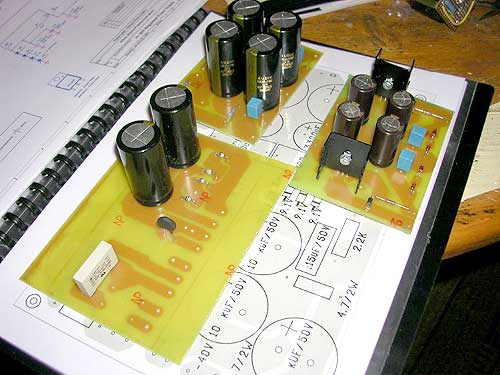Ian Mackenzie(DIY High-Low Crossover)
Miscellaneous Projects
About me
My name is Ian Mackenzie,
Here is my High Low Pass Active Crossover project.
I started on this project over 12 months ago after reading several threads on Diyaudio.com. In particular I was inspired by the Moamps Crossover article by Milan. Milan was very generous and helpful with the initial implementation.
Many others offered friendly tips including our leader and Diy Guru Nelson Pass.
I recall sending Karen a picture of my home made PCB, she replied it was beautiful!. That gave me a lot of confidence to proceed.
I have therefore dedicated this project to Karen who kindly offered assistance and support in so many ways.
For a long time I having been waiting for a really good diy active crossover project and I think this is it. All the filters are completely adjustable including the filter Q and slopes. The opamps are all discrete and use a Dual Jfet input and bipolar outputs. I have heard many chip based crossovers and disliked their sonic signature. In my opinion these discrete opamps impart very little sonic signature on the original audio signal.
The project has been a complete learning curve in all facets of diyaudio construction from making PCB's, to earthing, component selection and final adjustment.
I cut and pasted various pdf artwork to make up the layout and I used Kinston positive resist PCB boards and a fluorescent 40 watt tube for exposing the board. No fancy PCB software here! It took a long time to hand drill all the holes but it was fun. Next time I will make it double sided to avoid having to make a separate power supply and signal buss boards which are mounted under the main PCB. The earthing and power supply wiring is particularly important for least hum and noise. I had about three attempts at getting this right but it is now dead quiet. .
Sorting out what type of parts was also fun. Like all diy constructors I spent more days and restless nights thinking about what parts to buy than time actual installing the parts! In the end practicality, sensible design and logic prevailed.
I used Panasonic 6800 uf 63 volt audio grade power supply capacitors, polystyrene filter capacitors and currently Nichicon Fine Gold Muse coupling capacitors at the balanced outputs. I may end up using Black Gate N series in Super E configuration. Dale ¼ watt resisters almost exclusively and Nobel 10 K stereo level controls which are normal at full position
For quite a while I ran the crossover with coupling capacitors and used 220 uf Panasonic FC electro's bypassed by 0.47 stack Polypropylene metalised film capacitors. I then removed all the coupling capacitors and installed 25 turn trip pots on all the opamps to minimise Dc offset. Ultimately I found this to be only marginally successful and I am trialing Nichicon Gold Fine Muse capacitors on the balanced outputs where there appears to be least impact on sonic quality due to common mode cancellation of the opposing signal phases. These Muse capacitors are very good value for money.
The unregulated supply is based on a Diy Ono power supply and is housed in a separate box to minimise noise. It uses CRCRC filtering and then a zener/ power Fet series regulator like so many Passdiy projects. The crossover draws about 200 milliamps continuously.
The main box is made from 3mm aluminium plate and is held together by milled 25mm square posts that have been tapped with M4 bolts. I hand polished the panels with wet and dry paper and some wax polish. The labels are all thermal self adhesive
Adjusting the crossover was no simple matter. With all those filters one can go cross eyed and there are so many combinations. My requirement was for a stereo 2 way crossover with18 dB slopes at 290 hertz per my JBL 4345 bi-amped loudspeakers.
I decided recently to install a delay turn on and instant turn off transient suppresser. The unit uses 24 volt relays which short the outputs for about 3 seconds. I also mounted the output coupling capacitors on a length of vero board with the delay turn on circuit so this has a dual function of delay (de-thump) turn on and Dc speaker protection.
I am very pleased with how the whole thing works. As to the sound well I could talk for hours about that but I am sure many others will discover that after attempting this project.
Ian Mackenzie



















